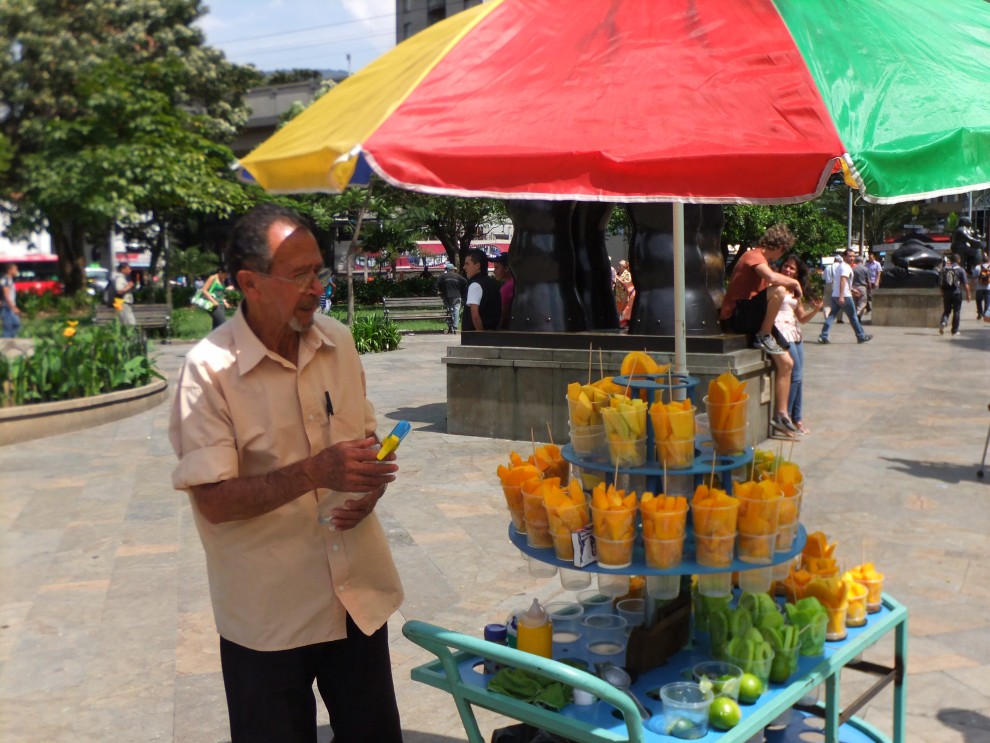This has to be said over and over, Colombia has changed. There’s a huge transition going on throughout the country, driven not only by government initiatives, but the communities themselves. Tired of living in fear, Colombians have reclaimed their streets and things are looking bright, in more ways than one.
The cosmopolitan valley city of Medellin is the second largest in Colombia, with a population of nearly three million, which has seen much in the way of urban renewal and development. It is located at 5,000 ft (1,500 m) above sea level, meaning its climate is not as hot as other cities located at the same latitude near the equator, and its average annual temperature is approximately 22 °C (72 °F) year round with minimal temperature variations.
The current city government officials are all working toward the same goal of making Colombia a safe and welcoming environment not only for its residents, but for tourists as well. The mayor of Medellin was quoted as saying, “Lighting up the city streets make them safer for people to be on them.” Nowhere is the success of this turnaround more evident than during the Christmas holiday period, where much of the city comes alive in a luminous affair billed as the Christmas Light Festival. The city immediately becomes a festival of sorts once December 1st hits, when fireworks can be heard throughout the city, and most of the residents and businesses also participate in the joyous atmosphere by creating their own illuminated displays.
Largely financed by the main energy supplier, the publicly owned Empresas Publicas de Medellín (EPM), a minimum of 30% of EPM’s profits also go directly to the city’s administrative budget funding a wide range of social and economic development policies. With its 18 million highly energy efficient lights, the city of Medellin is a site to behold at this time of year. The most impressive display is a dazzling creation of artistry that brings forth one of the most advanced laser and animation displays amid a triumphant musical background presented around EPM’s main headquarters. Once this spectacle ends, the crowd spills out onto the shores of the Medellin River where over 35 kilometres of the waterway are illuminated beneath a blanket of lights that connects about 70 locations in the capital district of Antioquia, which includes streets, parks, and urban icons.
The city is also working especially hard toward providing outreach to all youth, and this as well seems to be working. This is significantly evident in the “new north”, a sector of the city was once completely isolated to the rest of the core due to its inaccessibility on the upper reaches of the mountainside. It became a virtual war zone, with gang related gunfire and deaths happening on a daily basis. Today things have improved immensely with the opening of a multi-tier cable car system, and several new cultural institutions are attracting residents from throughout the city, creating what is referred to as a “social inclusive” environment.
One of the most visited sites is this sector is Arví Ecotourism Park that has an area of about 20,000 hectares, and is accessible at the final stop of the Metro Cable. Outdoor enthusiasts head here to discover trails, lakes, forests and streams that provide various sports and activities like trekking, kayaking, biking, camping, fishing, swimming, sailing, rowing, horseback riding, and other family friendly fun. The area also provides the best views of the city anywhere. Parque Explora is also in the “new north”, where visitors can explore the Botanical Garden, the largest Aquarium in South America, and a state-of-the-art Planetarium.
Noted 20th century artist Fernando Botero found the inspiration for his work in the daily life and drama of the city. He recently donated most of his works to the Museum of Antioquia, and in return the city dedicated the area surrounding the museum as Botero Square. The museum and square are now two of the most visited attractions in the city.
In late 2012 Medellin welcomed pop star Madonna to the city for two concerts, which was seen as yet another major advancement in moving toward a safe and welcoming environment, attracting thousands of visitors from outside the country. Next the city has its eyes on bidding to host the 2018 Summer Youth Olympics, which would just further propel it into the international spotlight. So for those who are able to see through the often-sensationalized unfavourable portrayal of Colombia, there will always be a bright light to be found.
Getting There
José María Córdova International Airport (MDE). American Airlines has daily flights from Miami with connections throughout North America.
Accommodations
Intercontinental Hotel – central location property with full amenities
The Charlee – trendy boutique property in the heart of the nightlife.
Other Attractions
Festival of Flowers is the most popular event in the city taking place in late July to early August with a huge parade, multiple events, and of course, flowers throughout. It’s along the same section of highway that’s used for the Christmas Lights Festival.
International Tango Festival is an expression of the tango culture that Medellín adopted as their own via a massive street dance party.
Museum of Modern Art of Medellín (MAMM) has a valuable collection of contemporary art comprised of sculptures, paintings, photographs, and prints by local and foreign artists.
Interactive Museum EPM is an educational tour that explains the physical principles of water, energy, gas and telecommunications.
Medellín is also known as the Milan of Latin America and hosts Latin America’s biggest fashion show, Colombiamoda.


